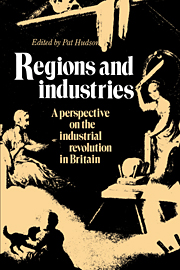Book contents
- Frontmatter
- Contents
- List of figures
- List of maps
- List of tables
- List of contributors
- Acknowledgements
- Introduction
- 1 The regional perspective
- PART ONE THE TEXTILE HEARTLANDS OF THE INDUSTRIAL REVOLUTION
- PART TWO OTHER PATHS, OTHER PATTERNS
- 4 Continuity and change in an industrialising society: the case of the West Midlands industries
- 5 Stages of industrialisation in Cumbria
- 6 The de-industrialisation process: a case study of the Weald, 1600–1850
- 7 Work, culture and resistance to machinery in the West of England woollen industry
- PART THREE THE DIVERSE NATURE OF THE OUTER REGIONS
- Index
4 - Continuity and change in an industrialising society: the case of the West Midlands industries
from PART TWO - OTHER PATHS, OTHER PATTERNS
Published online by Cambridge University Press: 05 May 2010
- Frontmatter
- Contents
- List of figures
- List of maps
- List of tables
- List of contributors
- Acknowledgements
- Introduction
- 1 The regional perspective
- PART ONE THE TEXTILE HEARTLANDS OF THE INDUSTRIAL REVOLUTION
- PART TWO OTHER PATHS, OTHER PATTERNS
- 4 Continuity and change in an industrialising society: the case of the West Midlands industries
- 5 Stages of industrialisation in Cumbria
- 6 The de-industrialisation process: a case study of the Weald, 1600–1850
- 7 Work, culture and resistance to machinery in the West of England woollen industry
- PART THREE THE DIVERSE NATURE OF THE OUTER REGIONS
- Index
Summary
In the West Midlands industrialisation was a long process rather than a series of discrete economic stages. It was the outcome of a continuous interplay of innovation and of continuity, and of diverse responses to pressure and to opportunity. The experience of this region supports recent work on industrialisation at national and international level, which stresses the importance of economic growth and structural change in society before 1760, and which suggests that between 1760 and 1850 economic growth was slower, and innovation more piecemeal, than was formerly believed.
The West Midlands displayed many of the features which have been recognised as encouraging industrialisation, including a pastoral economy, early agrarian capitalism, weak manorial controls and strong market incentives. Nevertheless, the region had its own special features, and adds another alternative to the many differing modes of industrialisation in the English regions. Its characteristics included marked continuity in the relations of production, the multiplication of units of production and the persisting importance of high-level skills of hand, brain and eye in the context of mass production. The most notable characteristic of the Midlands was diversity: of soils, of sizes of community, of products, of tenurial relations, of modes of organisation, of units of production and capitalisation, and of levels of wealth and poverty. This diversity was to prove an important influence in generating industrialisation in a form which was a significant alternative to factory mass production.
- Type
- Chapter
- Information
- Regions and IndustriesA Perspective on the Industrial Revolution in Britain, pp. 103 - 131Publisher: Cambridge University PressPrint publication year: 1989
- 4
- Cited by

